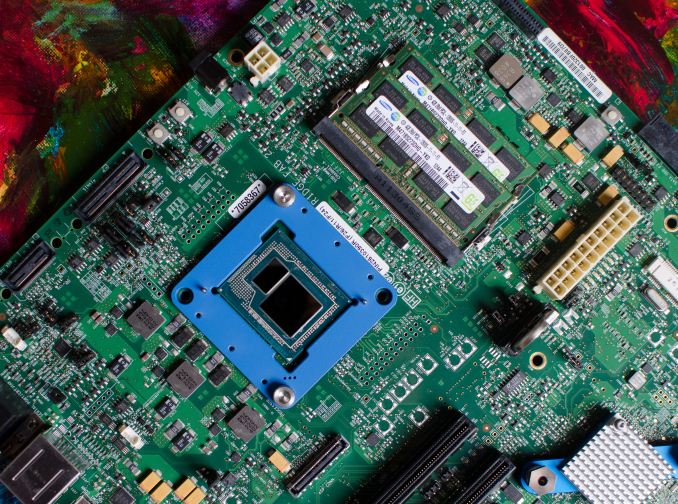Intel Iris Pro 5200 Graphics Review: Core i7-4950HQ Tested
by Anand Lal Shimpi on June 1, 2013 10:01 AM ESTFinal Words
For the past few years Intel has been threatening to make discrete GPUs obsolete with its march towards higher performing integrated GPUs. Given what we know about Iris Pro today, I'd say NVIDIA is fairly safe. The highest performing implementation of NVIDIA's GeForce GT 650M remains appreciably quicker than Iris Pro 5200 on average. Intel does catch up in some areas, but that's by no means the norm. NVIDIA's recently announced GT 750M should increase the margin a bit as well. Haswell doesn't pose any imminent threat to NVIDIA's position in traditional gaming notebooks. OpenCL performance is excellent, which is surprising given how little public attention Intel has given to the standard from a GPU perspective.
Where Iris Pro is dangerous is when you take into account form factor and power consumption. The GT 650M is a 45W TDP part, pair that with a 35 - 47W CPU and an OEM either has to accept throttling or design a cooling system that can deal with both. Iris Pro on the other hand has its TDP shared by the rest of the 47W Haswell part. From speaking with OEMs, Iris Pro seems to offer substantial power savings in light usage (read: non-gaming) scenarios. In our 15-inch MacBook Pro with Retina Display review we found that simply having the discrete GPU enabled could reduce web browsing battery life by ~25%. Presumably that delta would disappear with the use of Iris Pro instead.
Lower thermal requirements can also enabler smaller cooling solutions, leading to lighter notebooks. While Iris Pro isn't the fastest GPU on the block, it is significantly faster than any other integrated solution and does get within striking distance of the GT 650M in many cases. Combine that with the fact that you get all of this in a thermal package that a mainstream discrete GPU can't fit into and this all of the sudden becomes a more difficult decision for an OEM to make.
Without a doubt, gaming focused notebooks will have to stick with discrete GPUs - but what about notebooks like the 15-inch MacBook Pro with Retina Display? I have a dedicated PC for gaming, I use the rMBP for work and just need a GPU that's good enough to drive everything else in OS X. Intel's HD 4000 comes close, and I suspect Iris Pro will completely negate the need for a discrete GPU for non-gaming use in OS X. Iris Pro should also be competent enough to make modern gaming possible on the platform as well. Just because it's not as fast as a discrete GPU doesn't mean that it's not a very good integrated graphics solution. And all of this should come at a much lower power/thermal profile compared to the current IVB + GT 650M combination.
Intel clearly has some architectural (and perhaps driver) work to do with its Gen7 graphics. It needs more texture hardware per sub-slice to remain competitive with NVIDIA. It's also possible that greater pixel throughput would be useful as well but that's a bit more difficult to say at this point. I would also like to see an increase in bandwidth to Crystalwell. While the 50GB/s bi-directional link is clearly enough in many situations, that's not always the case.
Intel did the right thing with making Crystalwell an L4 cache. This is absolutely the right direction for mobile SoCs going forward and I expect Intel will try something similar with its low power smartphone and tablet silicon in the next 18 - 24 months. I'm pleased with the size of the cache and the fact that it caches both CPU and GPU memory. I'm also beyond impressed that Intel committed significant die area to both GPU and eDRAM in its Iris Pro enabled Haswell silicon. The solution isn't perfect, but it is completely unlike Intel to put this much effort towards improving graphics performance - and in my opinion, that's something that should be rewarded. So I'm going to do something I've never actually done before and give Intel an AnandTech Editors' Choice Award for Haswell with Iris Pro 5200 graphics.
This is exactly the type of approach to solving problems I expect from a company that owns around a dozen modern microprocessor fabs. Iris Pro is the perfect example of what Intel should be doing across all of the areas it competes in. Throw smart architecture and silicon at the problem and don't come back whining to me about die area and margins. It may not be the fastest GPU on the block, but it's definitely the right thing to do.
I'm giving Intel our lowest award under the new system because the solution needs to be better. Ideally I wouldn't want a regression from GT 650M performance, but in a pinch for a mostly work notebook I'd take lower platform power/better battery life as a trade in a heartbeat. This is absolutely a direction that I want to see Intel continue to explore with future generations too. I also feel very strongly that we should have at least one (maybe two) socketed K-series SKUs with Crystalwell on-board for desktop users. It is beyond unacceptable for Intel to not give its most performance hungry users the fastest Haswell configuration possible. Most companies tend to lose focus of their core audience as they pursue new markets and this is a clear example of Intel doing just that. Desktop users should at least have the option of buying a part with Crystalwell on-board.
So much of Intel's march towards improving graphics has been driven by Apple, I worry about what might happen to Intel's motivation should Apple no longer take such an aggressive position in the market. My hope is that Intel has finally realized the value of GPU performance and will continue to motivate itself.












177 Comments
View All Comments
DanaGoyette - Saturday, June 1, 2013 - link
Any idea if this IGP supports 30-bit color and/or 120Hz displays?Currently, laptops like the HP EliteBook 8770w and Dell Precision M6700 haven't been able to use Optimus if you opt for such displays. It would be nice to see that question addressed...
DickGumshoe - Saturday, June 1, 2013 - link
I have been planning on getting a Haswell rMBP 15". I was holding out for Haswell namely due to the increased iGPU performance. My primary issue with the current Ivy Bridge rMBP is the lagginess with much of the UI, especially when there are multiple open windows.However, I'm a bit concerned about how the Haswell CPU's will compare with the current Ivy Bridge CPU's that Apple is currently shipping with the rMBP. The Haswell equivalent of the current rMBP Ivy Bridge CPU's do not have the Iris Pro, they only have the "slightly improved" HD 4600.
Obviously, we still need to wait until WWDC, but based on the released Haswell info, will Haswell only be a slight bump in performance for the 15" rMBP? If so, that is *very* disappointing news.
hfm - Saturday, June 1, 2013 - link
This is a huge win for Intel, definitely performance on par with a 650M. It's just as playable on nearly all those games at 1366x768. Even though the 650M pulls away at 1600X900, I wouldn't call either gpu playable in most of those games at that resolution.you look at it intelligently, this is a huge win by Intel. The 750M may save them, but if I was in the market for an Ultrabook to complement my gaming notebook, I would definitely go with iris pro. Hell, even if I didn't have a dedicated gaming notebook I would probably get iris Peru in my Ultrabook just for the power savings, it's not that much slower at playable resolution.
IntelUser2000 - Tuesday, June 4, 2013 - link
Iris Pro 5200 with eDRAM is only for the quad core standard notebook parts. The highest available for the Ultrabook is the 28W version, the regular Iris 5100. Preliminary results shows the Iris 5100 to be roughly on par with Desktop HD 4600.smilingcrow - Saturday, June 1, 2013 - link
For those commenting about pricing Intel has only released data for the high end Iris Pro enabled SKUs at this point and cheaper ones are due later.The high end chips are generally best avoided due to being poor value so stay tuned.
whyso - Saturday, June 1, 2013 - link
Yes, the rmbp is clearly using 90 watts on an 85 watt power adapter for the WHOLE SYSTEM!gxtoast - Sunday, June 2, 2013 - link
Question for Anand:I'm looking at getting a Haswell 15" Ultrabook with 16GB RAM and plenty of SSD to run up come fairly sophisticated Cisco, Microsoft and VMware cloud labs.
Is it likely that the Crystalwell cache could offset the lower performance specifications on the 4950HQ to make it as competitive, or more so, against the 4900MQ in this scenario?
It would also be good to understand the performance improvement, for non-game video tasks, the HQ part might have over the 4900MQ on a FHD panel. If the advantage isn't there, then, unless the Crystalwell makes a big difference, the 4900MQ part is likely the one to get.
Cheers
piesquared - Sunday, June 2, 2013 - link
Question. Why in Kabini reviews did we get the standard "just wait til intel releases their next gen parts to see the real competion OMGBBSAUCE!!" marketing spiel, while not a mention that hsw's competition is Kaveri?IntelUser2000 - Sunday, June 2, 2013 - link
Uhh, because Haswell launch was less than a month away from Kabini, while Kaveri is 6+ months away from Haswell?AMD paper launched Kabini and Richland in March, and products are coming now. Kaveri claims to be late Q4 for Desktop and early Q1 next year for mobile. If they do the same thing, that means Feb-March for Desktop Kaveri and April/May for Mobile. Yeah.... perhaps you should think about that.
JarredWalton - Sunday, June 2, 2013 - link
The Kabini article never said, "just wait and see what Intel has coming!" so much as it said, "We need to see the actual notebooks to see how this plays out, and with Intel's Celeron and Pentium ULV parts are already at Kabini's expected price point, it's a tough row to hoe." Kabini is great as an ARM or Atom competitor; it's not quite so awesome compared to Core i3, unless the OEMs pass the price savings along in some meaningful way. I'd take Kabini with a better display over Core i3 ULV, but I'll be shocked if we actually see a major OEM do Kabini with a quality 1080p panel for under $500.